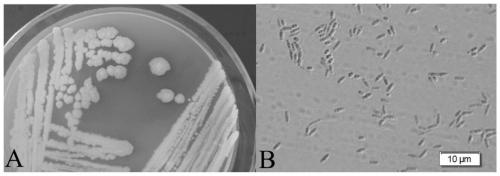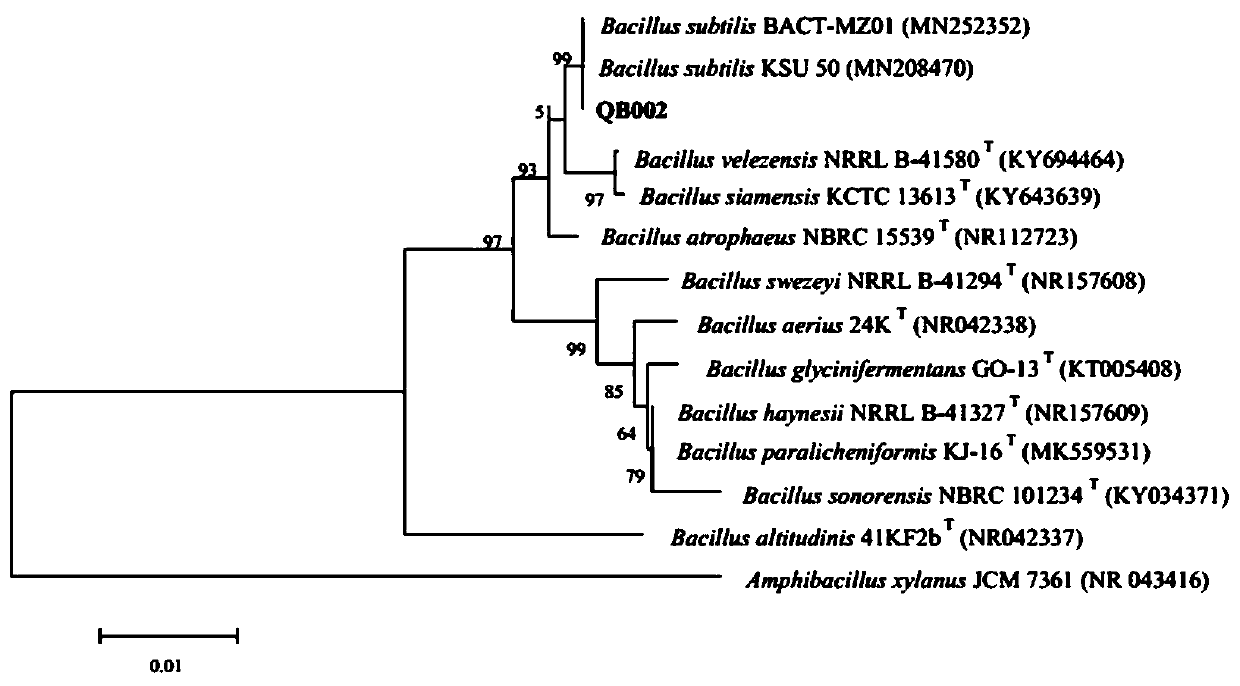Walnut branch blight antagonizing bacteria and application thereof
A technology of walnut branches and Bacillus subtilis, applied in the fields of microbiology and plant disease prevention and control, can solve the problems of antagonizing Juglanconis juglandina biocontrol strains, etc., and achieve good biocontrol potential and significant effect
- Summary
- Abstract
- Description
- Claims
- Application Information
AI Technical Summary
Problems solved by technology
Method used
Image
Examples
Embodiment 1
[0030] Example 1 Isolation and identification of Bacillus subtilis (Bacillus subtilis) QB002
[0031] 1. Isolation of antagonistic bacteria
[0032] Disease specimens were collected in different regions of Xinjiang, and bacterial strains were isolated by tissue separation method. Single colony plates with different shapes were picked and cultured and streaked on NA medium. Observation and record of edge shape, etc., pick a single colony and store it at 4°C for later use.
[0033] 2. Identification of antagonistic bacteria
[0034] 2.1 Bacterial morphology observation and Biolog analysis and identification
[0035] Observe the culture morphology and Gram staining of QB002 strain. After the strain QB002 was cultured on NA medium for 24 hours, the single colony was light yellow, irregular in shape, with folds in the middle, opaque, moist in texture and not smooth on the surface. Gram staining is purple, it is Gram-positive bacteria, and the bacteria are short rod-shaped ( f...
Embodiment 2
[0048] The growth inhibitory effect of embodiment 2 bacillus subtilis QB002 to walnut branch blight
[0049] The inhibitory effect of strain QB002 on walnut branch blight was determined by plate confrontation culture method. Take the purified cultured pathogenic bacteria cake with a diameter of 5 mm and place it in the center of the PDA plate. The strain QB002 was activated on NA medium, cultured at constant temperature for 24 hours, a single colony was picked and drawn at a distance of 2 cm from the pathogenic bacteria, and only the pathogenic bacteria were inoculated as a control, and each treatment was repeated 3 times. Cultivate at a constant temperature of 28°C. When the control colonies cover the plate, observe and measure the width of the inhibition zone and the growth diameter of the bacteria, calculate the growth inhibition rate of the colonies, and screen out the bacteria with the best antagonistic effect.
[0050]
[0051] A strain QB002 ( Figure 4 ), its inhi...
Embodiment 3
[0052] Example 3 Preliminary Study on the Antibacterial Mechanism of Bacillus subtilis QB002
[0053] The inhibitory effect of the active substance of the antagonistic strain QB002 on the hyphae of Juglanconis juglandina was carried out using the plate confrontation method. A 5mm diameter bacterial cake of pathogenic bacteria was placed in the center of the PDA plate, and a sterile cover glass was placed around 1cm away from the center of the plate. After the growth of hyphae, the bacteria QB002 was streaked at a distance of 1 cm from the cover glass, and cultured at 30°C for 3 days. Taking the hyphae only inoculated with the pathogen as a control, the effect of the active product of the antagonistic bacterium QB002 on the morphology of the mycelium of the pathogen was observed under an optical microscope. The results showed that the inhibitory rate of antagonistic bacteria on the growth of walnut branch blight pathogen reached 88.6%. The hyphae of the pathogen (Juglanconis j...
PUM
 Login to View More
Login to View More Abstract
Description
Claims
Application Information
 Login to View More
Login to View More - R&D
- Intellectual Property
- Life Sciences
- Materials
- Tech Scout
- Unparalleled Data Quality
- Higher Quality Content
- 60% Fewer Hallucinations
Browse by: Latest US Patents, China's latest patents, Technical Efficacy Thesaurus, Application Domain, Technology Topic, Popular Technical Reports.
© 2025 PatSnap. All rights reserved.Legal|Privacy policy|Modern Slavery Act Transparency Statement|Sitemap|About US| Contact US: help@patsnap.com



